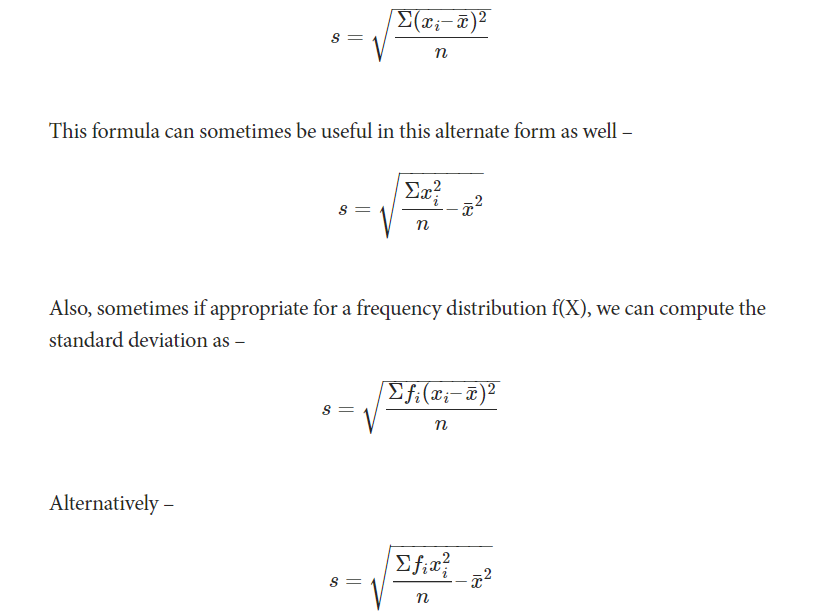Mode is a measure of central tendency that identifies the most frequently occurring value or values in a dataset. Unlike the mean or median, the mode can be used for both numerical and categorical data. A dataset may have one mode (unimodal), more than one mode (bimodal or multimodal), or no mode at all if no value repeats. The mode is particularly useful for understanding trends in categorical data, such as the most popular product, common response, or frequent event, and is less sensitive to outliers compared to other central tendency measures.
Examples:
For example, in the following list of numbers, 16 is the mode since it appears more times than any other number in the set:
- 3, 3, 6, 9, 16, 16, 16, 27, 27, 37, 48
A set of numbers can have more than one mode (this is known as bimodal if there are 2 modes) if there are multiple numbers that occur with equal frequency, and more times than the others in the set.
- 3, 3, 3, 9, 16, 16, 16, 27, 37, 48
In the above example, both the number 3 and the number 16 are modes as they each occur three times and no other number occurs more than that.
If no number in a set of numbers occurs more than once, that set has no mode:
Characteristics of Mode:
Mode can be applied to both qualitative (categorical) and quantitative data. For example, in market research, the mode can identify the most common product color or customer preference.
The mode is not influenced by extreme values or outliers in a dataset. For instance, in a dataset of salaries where most values are clustered around a certain range but a few extreme salaries exist, the mode will still reflect the most frequent salary, making it a useful measure when dealing with skewed data or anomalies.
A dataset may have more than one mode. If there are two values that occur with the same highest frequency, the dataset is considered bimodal. If there are more than two, it is multimodal. In such cases, the mode provides insight into multiple frequent occurrences within the dataset, unlike the mean or median, which offer a single value.
In some datasets, there may be no mode if all values occur with equal frequency. For example, in a dataset where every value appears only once, the mode is undefined. Conversely, in datasets with a clear most frequent value, the mode is uniquely defined.
The mode is simple to compute. It only requires identifying the value that appears most frequently in the dataset. No complex formulas or data manipulations are needed, making it a straightforward measure for quick analysis.
The mode is especially useful for categorical data where numerical calculations do not apply. For instance, in surveys where respondents choose their favorite color, the mode will show the most popular choice, providing valuable insights in marketing or social studies.
Applications of Mode:
-
Market Research
In market research, the mode is used to identify the most popular product, service, or customer preference. For example, if a survey is conducted to determine consumers’ favorite brands, the mode will highlight the brand chosen most frequently, helping businesses focus on popular trends.
-
Fashion and Retail Industry
The mode is widely used in the fashion and retail sectors to determine popular product styles, colors, or sizes. For example, if a clothing store wants to know the most commonly bought color of a particular item, the mode will provide the answer, guiding inventory decisions and promotional strategies.
-
Educational Testing
In educational assessments, the mode can be used to determine the most common score or grade achieved by students in a test or examination. This helps educators identify common performance trends and understand the difficulty level of the assessment.
-
Health and Medical Statistics
In healthcare, the mode is used to find the most common age group, symptom, or diagnosis within a population. For example, in a study of common diseases, the mode can reveal the most frequently occurring disease or the most prevalent age group affected, providing insights into public health needs.
-
Consumer Behavior Analysis
In consumer behavior studies, the mode is used to determine the most frequently chosen option in surveys and polls. For instance, it can highlight the most common reasons for customer dissatisfaction or preferences regarding product features, aiding companies in product development and customer service strategies.
-
Sports Statistics
In sports analytics, the mode is used to identify the most frequent performance metric. For example, the mode can be applied to identify the most common score in a set of matches or the most frequent outcome of a particular game, assisting coaches and analysts in understanding patterns in performance.
Advantages:
- It is easy to understand and simple to calculate.
- It is not affected by extremely large or small values.
- It can be located just by inspection in un-grouped data and discrete frequency distribution.
- It can be useful for qualitative data.
- It can be computed in an open-end frequency table.
- It can be located graphically.
Disadvantages:
- It is not well defined.
- It is not based on all the values.
- It is stable for large values so it will not be well defined if the data consists of a small number of values.
- It is not capable of further mathematical treatment.
- Sometimes the data has one or more than one mode, and sometimes the data has no mode at all.
Like this:
Like Loading...
